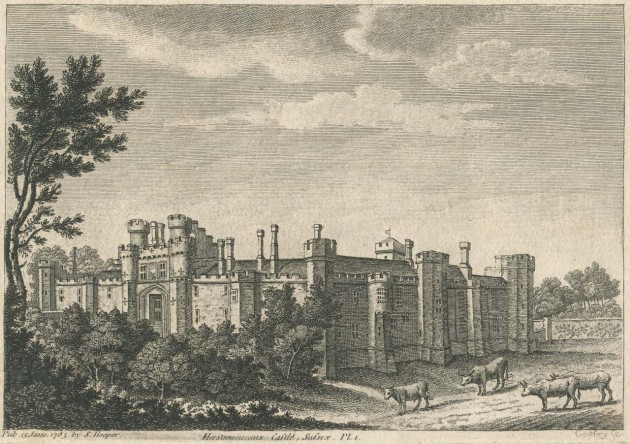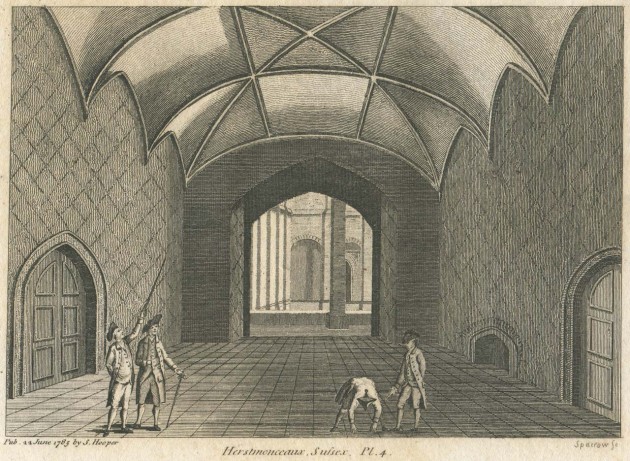…where east meets west
- Home
- Brief History
- The Greenwich Meridian
- Greenwich
(1675–1958) - Herstmonceux
(1948–1990) - Cambridge
(1990–1998) - Outstations (1822–1971)…
- – Chingford (1822–1924)
- – Deal
(1864–1927) - – Abinger
(1923–1957) - – Bristol & Bradford on Avon
(1939–1948) - – Bath
(1939–1949) - – Hartland
(1955–1967) - – Cape of Good Hope
(1959–1971)
- Administration…
- – Funding
- – Governance
- – Inventories
- – Pay
- – Regulations
- – Royal Warrants
- Contemporary Accounts
- People
- Publications
- Science
- Technology
- Telescopes
- Chronometers
- Clocks & Time
- Board of Longitude
- Libraries & Archives
- Visit
- Search
Herstmonceux Castle (eighteenth century engravings)
Herstmonceux Castle has been described as the finest early brick building in England. Begun in 1441, it was partially dismantled in 1777. It remained a ruin until the early 20th century when it was converted back into a residence (but with a different room plan). It was occupied by the Royal Observatory from 1948 until the end of the 1980s when the Observatory was moved to Cambridge.
The Royal Observatory at Herstmonceux
Herstmonceux Castle in old photographs (1850–1910)
Engravings published in The antiquities of England and Wales (1785)
By the start of the 1770s, the castle had fallen into a state of disrepair. In 1775, it was inherited by the Reverend Robert Hare who lived nearby at Herstmonceux place. He decided that it was uneconomic to repair the Castle and drew up plans with the architect Samuel Wyatt to dismantle the castle interior and use the materials to augment his own house instead. This it seems upset Thomas Lennard, Lord Dacre, a descendent of the family that had owned the Castle until 1708. As a result, Lennard commissioned James Lambert of Lewes to create a set of drawings of the Castle prior to the work commencing. Most of these were completed by him and his nephew (also called James Lambert) in 1776.
In 1776, the Castle had four internal courtyards, of which the Green Court was by far the largest. The others, in diminishing size order were: the Pump Court, the Chicken Court and the Butler’s Pantry Court. When the castle was reconstructed at the start of the twentieth century, it was decided not to reinstate them and the internal buildings, but to create a single much larger courtyard instead.
Francis Grose included engravings based on four of the Lambert drawings in volume 5 of his multi-volume set: The antiquities of England and Wales (published in 1785). Grose however records in the index that they were engraved from drawings by Mr Grimm, (who had copied them from those done by the Lamberts).
The four engravings were all published by S. Hooper in 1785 – plate 1 on 15 June and plates 2, 3 and 4 on 22 June. Plates 1–3 derive from the drawings of James Lambert senior, whilst plate 4 derives from one by his nephew. Plates 1 and 2 were engraved by Sparrow and plate 4 by Godfrey. The engraver of plate 3 is not recorded.
Click here to read Grose’s accompanying description of the Castle.
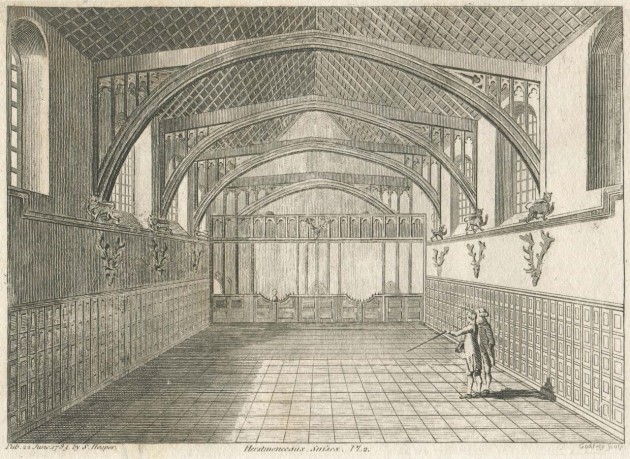
Plate 2: The great-hall. The great-hall was on the north side of the Green Court. It ran from east to west with the Butlers Court abutting it to the north (right)
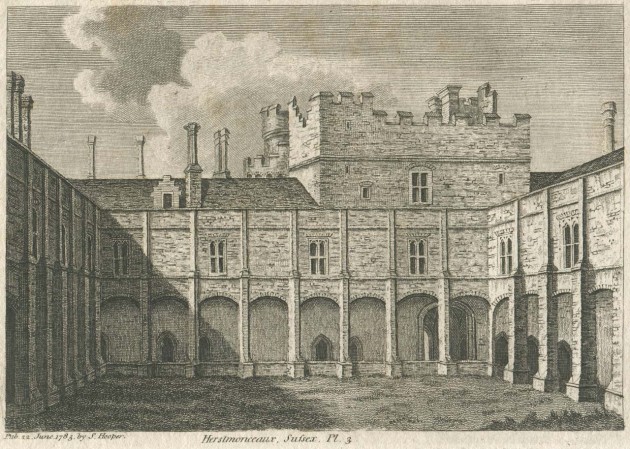
Pate 3: The south view of the Green Court. The Green Court occupied the south-east quarter of the present courtyard. It had cloisters on all four sides. The tower is the central gatehouse with its porter's lodge on the ground floor. Plate 4 (below) was drawn there and shows the view looking northwards through the large arch on the right and on into the Green Court
In 2005, Lamberts’ volume consisting of two plans of the Castle (undated) and thirteen drawings (eleven dated 1776, one dated 1777 and one undated with the Dairy House ‘airbrushed out’) was sold for £7,440 (hammer price at the Sotherby’s sale on 24 November). In the following February, the purchaser sold them on to the East Sussex Records Office for £12,000. They have since been digitised. Click here to see them. Grimm’s copies are now in the collections of the Yale Centre for British Art and can be viewed by clicking here. A collection of 14 preparatory drawings are in the collections of the Victoria and Albert Museum, and have all been digitised (click here to view)
Plans of the Castle in 1776
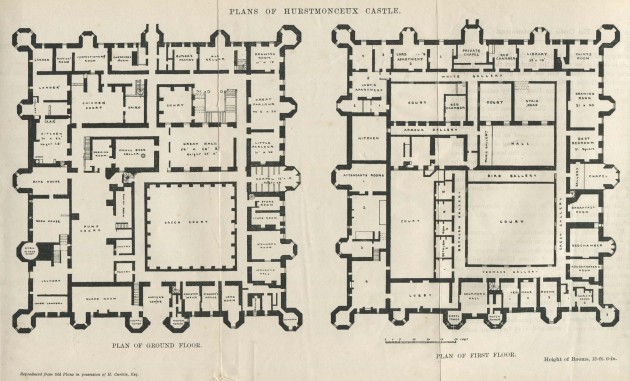
Undated plans of the Castle prior to its partial demolition in the 1770s. They appear to have been copied from those drawn by James Lambert in 1776, but with some small changes to the annotation. From Crake's The castle and church of Hurstmonceux (c.1890)
Further Reading
The drawings of Herstmonceux Castle by James Lambert, senior and junior, 1776–7. John H. Farrant, Sussex archaeological collections Vol 148, pp. 177–81 (2010)
© 2014 – 2025 Graham Dolan
Except where indicated, all text and images are the copyright of Graham Dolan
